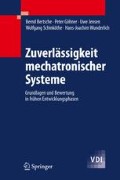Zusammenfassung
In diesem Kapitel werden zum einen die Regressionsmodelle der Lebensdaueranalyse vorgestellt. Zum anderen werden mathematische Modelle zur Beschreibung komplexer Systeme betrachtet, welche aus Komponenten zusammengesetzt sind. Mögliche Abhängigkeiten zwischen den Lebensdauern der Komponenten werden durch so genannte Copula-Modelle beschrieben, die es unter anderem ermöglichen, den Einfluss des Grades der Abhängigkeit auf die Zuverlässigkeit des Gesamtsystems zu untersuchen.
Access this chapter
Tax calculation will be finalised at checkout
Purchases are for personal use only
Preview
Unable to display preview. Download preview PDF.
Literatur
Aalen O O (1980) A Model for Nonparametric Regression of Life Times. In: Kozek A, Rosinski J (Eds.) Mathematical Statistics and Probability Theory, Vol 2 of Lecture Notes in Statistics, Springer, New York: 1–23
Aalen O O, Borgan O, Gjessing S (2008) Survival and Event History Analysis: A Process Point of View. Springer, New York
Andersen P K, Borgan O, Gill RD, Keiding N (1993) Statistical Models Based on Counting Process. Springer, New York
Aven T, Jensen U (1999) Stochastic Models in Reliability. Springer, New York
Barlow R, Proschan F (1975) Statistical Theory of Reliability. Wiley, New York
Beichelt F (1993) Zuverlässigkeits- und Instandhaltungstheorie. Teubner, Stuttgart
Beichelt F (1995) Stochastik für Ingenieure – Einführung in die Wahrscheinlichkeitstheorie und Mathematische Statistik. Teubner, Stuttgart
Birnbaum, Z W (1969) On the importance of different components in a multicomponent system. In: Krishnajah PR (ed) Multivariate Analysis II, Academic Press: 581–592
Cox D R (1972) Regression Models and Life Tables. J. Roy. Statist. Soc. Ser. B 34: 187–220
DIN 3990 Tragfähigkeitsberechnung von Stirnrädern
Dufner J, Jensen U, Schumacher E (2004) Statistik mit SAS. Teubner, Stuttgart
Fleming T, Harrington D (1991) Counting Processes and Survival Analysis. Wiley, New York
Gandy A (2002) A Nonparametric Additive Risk Model with Application in Software Reliability. Diplomarbeit, Universität Ulm
Gandy A (2005) Directed Model Checks for Regression Models from Survival Analysis. Dissertation, Universität Ulm, Logos Verlag, Berlin
Gandy A (2005) Effects of Uncertainties in Components on the Survival of Complex Systems with Given Dependencies. In: Wilson A, Limnios N, Keller-McNulty S, Armijo Y (eds) Modern Statistical and Mathematical Methods in Reliability. Worls Scientific, New Jersey: 177–189,
Gandy A, Jensen U (2004) A nonparametric approach to software reliability. Appl. Stoch. Models Bus. Ind. 20: 3–15
Gandy A, Jensen U (2005) On Goodness of Fit Tests for Aalen’s Additive Risk Model. Scandinavian Journal of Statistics 32: 425–445
Gandy A, Jensen U (2005) Checking a Semiparametric Additive Risk Model. Lifetime Data Analysis 11: 451–472
Gandy A, Jensen U (2007) Model Checks for Cox-Type Regression Models Based on Optimally Weighted Martingale Residuals. Preprint, Universität Hohenheim
Gandy A, Jensen U, Köder T, Schinköthe W (2005) Ausfallverhalten bürstenbehafteter Kleinantriebe. Mechatronik F&M 11-12: 14–17
Gandy A, Jensen U, Lütkebohmert C (2005) A Cox Model with a Change-Point Applied to an Actuarial Problem. Brazilian Journal of Probability and Statistics 19: 93–109
Gandy A, Jäger P, Bertsche B, Jensen U (2006) Berücksichtigung von Ungenauigkeiten bei Zuverlässigkeitsanalysen in frühen Entwicklungsphasen. Konstruktion 6: 78–82
Gandy A, Jäger P, Bertsche B, Jensen U (2007) Decision Support in Early Development Phases – A Case Study from Machine Engineering. Reliability Engineering & System Safety 92: 921–929
GNOME project (2003) http://www.gnome.org
Goel A L, Okumoto K (1979) Time-dependent Error-detection Rate Model for Software Reliability and other Performance Measures. IEEE Transactions on Reliability R-28: 206–211
Jäger P, Wedel M, Gandy A, Bertsche B, Göhner P, Jensen U (2005) Zuverlässigkeitsbewertung softwareintensiver mechatronischer Systeme in frühen Entwicklungsphasen. VDI Konferenz Mechatronik, Wiesloch bei Heidelberg
Jelinski Z, Moranda P (1972) Software Reliability Research. In: Freiberger W (Ed.) Statistical Computer Performance Evaluation. Academic Press, New York
Jensen U, Lütkebohmert C (2007) Change-Point Models. Review in: Ruggeri F, Kenett R, Faltin W (eds-in-chief) Encyclopedia of Statistics in Quality and Reliability. In section: Shelemyahu Zacks (section ed) Statistical and Stochastic Modeling. Vol 1: 306–312, Wiley New York
Jensen U, Lütkebohmert C (2008) A Cox-type Regression Model with Change-Points in the Covariates. Lifetime Data Analysis 14: 267–285
Jensen U, Lütkebohmert C (2008) A Transformation Model Based on Bent-Line Change-Points in the Covariates. Preprint, Universität Hohenheim
Joe H (1997) Multivariate Models and Dependence Concepts. Chapman & Hall/CRC, Boca Raton
Kalbfleisch J D, Prentice R L (2002) The Statistical Analysis of Failure Time Data. Wiley, New York
Krengel U (2003) Einführung in die Wahrscheinlichkeitstheorie und Statistik. Vieweg, Wiesbaden
Lütkebohmert C (2003) Counting process models of software reliability and their statistical analysis. Diplomarbeit, Universität Ulm
Lütkebohmert-Marhenke C (2007) Cox-type Regression and Transformation Models with Change-Points based on Covariate Thresholds. Dissertation, Universität Hohenheim
Lütkebohmert C, Jensen U, Beier M, Schinköthe W (2007) Wie lange lebt mein Kleinmotor? – Ausfallverhalten und statistische Analyse. Mechatronik 9: 40–43
Musa J D (1980) Software reliability data. Technical Report, Data and Analysis Center for Software
Nelson R B (2006) An introduction to copulas. Springer, New York
Singpurwalla N D, Wilson S P (1999) Statistical Methods in Software Engineering. Springer, New York
Therneau T, Grambsch P, Fleming T (1990) Martingale-based residuals for survival
Wedel M, Jensen U, Göhner P (2008) Mining Software Code Repositories and Bug Databases using Survival Analysis Models. Proceeding ESEM
Xie M (1991) Software Reliability Modelling, World Scientific, Singapore
Zimmermann T, Premraj R, Zeller A (2007) Predicting defects for eclipse. In Proceedings Promise repository of empirical software engineering data. http://promisedata.org, Software Engineering Chair, Saarland Universität
Rights and permissions
Copyright information
© 2009 Springer-Verlag Berlin Heidelberg
About this chapter
Cite this chapter
Jensen, U., Döring, M., Gandy, A., Mathe, K. (2009). Mathematische Modelle zur quantitativen Analyse der Zuverlässigkeit. In: Zuverlässigkeit mechatronischer Systeme. VDI-Buch. Springer, Berlin, Heidelberg. https://doi.org/10.1007/978-3-540-85091-5_4
Download citation
DOI: https://doi.org/10.1007/978-3-540-85091-5_4
Publisher Name: Springer, Berlin, Heidelberg
Print ISBN: 978-3-540-85089-2
Online ISBN: 978-3-540-85091-5
eBook Packages: Computer Science and Engineering (German Language)

